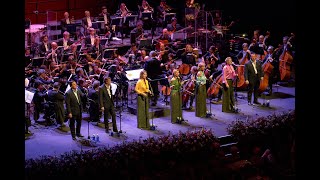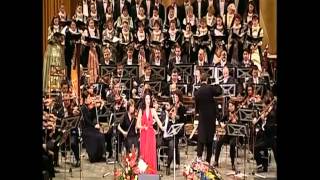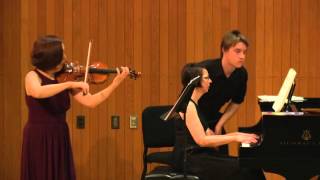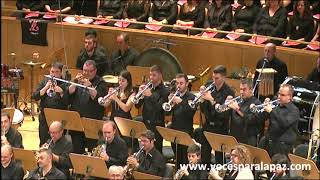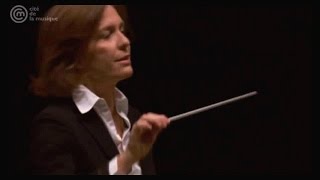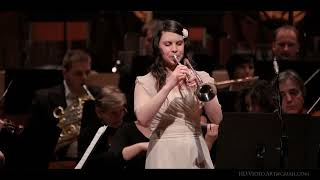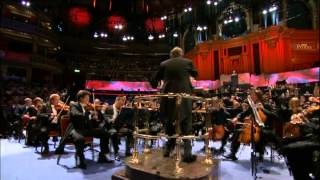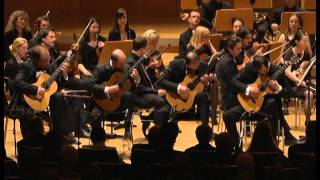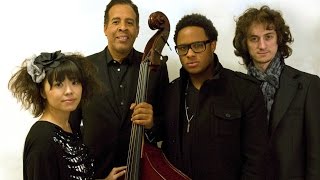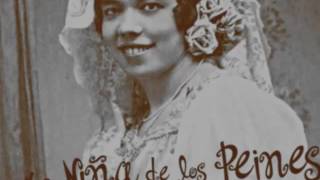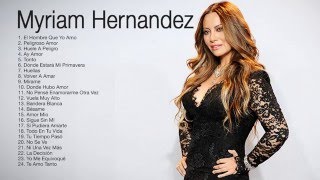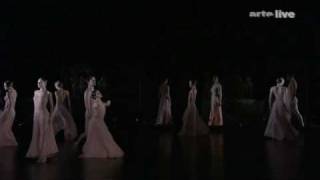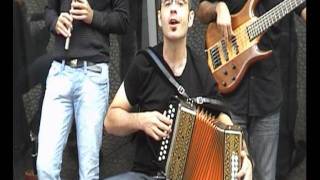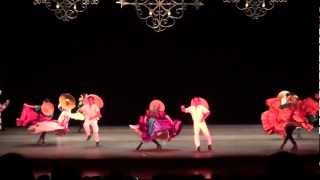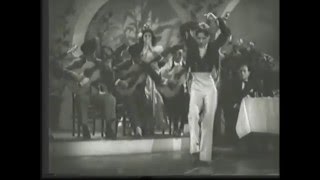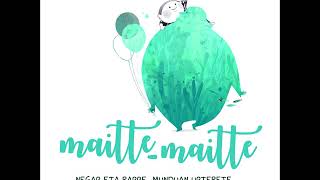From June 4th to 9th, the Rocío Pilgrimage is celebrated.
Recommended music videos for initiation to classical music
The Romería de El Rocío —popularly known as El Rocío— is a popular and religious celebration in honor of the Virgin of El Rocío , which takes place in May or June, at the time of Pentecost . It was classified in 1965 as a Festival of National Tourist Interest and in 1980 as a Festival of International Tourist Interest and has experienced great growth since the mid -20th century . During the festival, hundreds of thousands of devotees and tourists gather in the village of El Rocío de Almonte , province of Huelva , in a festival that unites religious, folkloric, environmental and recreational characters.
The pilgrimage begins on Saturday (this year, the 7th) with the recitation of the Holy Rosary . The night from Sunday to Monday is the height of collective fervor. This is when the Virgin reunites with her faithful in the procession that begins with the spectacular "jump over the fence." To the cries of " Long live the White Dove! ", the Virgin is carried in procession and sways at the first light of dawn. The celebration ends when the Virgin returns to her hermitage on Monday morning (this year, the 9th), entrusting herself to the White Dove until the following year. The Virgin of Rocío is popularly known as the " White Dove " in reference to the Feast of Pentecost , when the Holy Spirit visited the Virgin and the Apostles in the form of a dove.
Manuel Pareja-Obregón (1933-1995) was a musician and composer from Seville. His compositions include sevillanas and fandangos de Huelva . He played a key role in introducing Andalusian popular music into mainstream culture, introducing orchestral arrangements where previously only guitar and sticks had been played. He composed some 3,000 works for a large group of famous Spanish stage artists. In 1987, he founded the school of drummers in the village of El Rocío , later known as the Tamborileros de Nuestra Señora del Rocío . He died in Seville at the age of 62 from leukemia, which had kept him hospitalized for the last two months of his life. He was cremated and his ashes were scattered in the village of El Rocío .
The Salve Rociera is the salve sung to the Virgin of Rocío , at the Sanctuary of El Rocío in Almonte (Huelva). El Rocío , as the entire pilgrimage is traditionally called, is a phenomenon between religious and folkloric, which moves more than a million people on the days of celebration in the month of May or June (depending on the variable feast of Pentecost ) who come to the hermitage to venerate the Virgin. It was precisely for the Pilgrimage of El Rocío , the Salve Rociera that Manuel Pareja-Obregón composed, also known as Salve to the Virgin of Rocío or Salve del olé , with lyrics by Rafael de León. Today we present it in a version by Siempre Así , a popular music group from Seville, accompanied by the Royal Symphony Orchestra of Seville , all of them under the direction of the English maestro John Richard Durant
Charles Gounod (1818-1893) was a French composer best known to the general public for his Ave Maria , which we offer today. He was born in Paris and received his first classes from his mother until he enrolled at the Conservatoire . He was a very prolific composer of both sacred and secular works; among them, his opera Faust deserves special mention. His influence on other French composers such as Bizet, Saint-Saëns and Jules Massenet is undeniable. Even Debussy himself came to declare him "necessary" in that his aesthetics represented for that generation of French people a powerful counterweight to the overwhelming Wagnerian thrust .
Bach/Gounod 's Ave Maria is a composition on the Latin text Ave Maria originally published in 1853. The piece consists of a melody by Gounod , designed to be superimposed over Prelude No. 1 in C major, BWV 846, from Book I of J.S. Bach 's The Well-Tempered Clavier written 137 years earlier.
Along with Schubert 's Ave Maria , Bach-Gounod 's Ave Maria has become a fixture at weddings, funerals, and other celebrations of all kinds. There are many different arrangements for guitar, violin, string quartet, piano, cello, trombone ensemble, opera singers, choirs, and so on, which have recorded and/or performed it in public hundreds of times during the 20th century .
Today it is offered to us by the Romanian soprano Angela Gheorghiu .
Emilie Mayer (1812–1883) was a German composer and sculptor of the Romantic era . Although she began her composition studies relatively late in life, she was a prolific composer and was highly regarded throughout Europe , composing at least eight major symphonies, fifteen concert overtures, and a large body of chamber music. On August 28, 1840, her life took a surprising turn when her father shot himself, the 26th anniversary of the death of Emilie Mayer 's mother. Author Marie Silling wrote of this event: "Her father's death caused her first great sorrow; in order to numb this pain, she buried herself in work."
A nocturne is a piece of vocal or instrumental music with a sweet melody and free structure. The term "nocturne" was first used in the 18th century to describe a piece played in fits and starts, usually at evening parties, and then dropped. In its most common form (as a single-movement piece, usually written for solo piano), the genre was cultivated primarily in the 19th century . The first nocturnes written under this name were by John Field , considered the father of the Romantic nocturne , which has a characteristic cantabile melody with arpeggiated accompaniment. The most famous exponent of this music, however, was Frédéric Chopin , who wrote 21 works in this genre.
Today we offer an excerpt from Emilie Mayer 's Nocturne , performed by the Kobayashi/Gray duo.
Leroy Anderson (1908–1975) was an American composer of short orchestral light music pieces, many of which were premiered by the Boston Pops Orchestra under Arthur Fiedler . John William S has described him as "one of the greatest American masters of light orchestral music". Anderson received his first piano lessons from his mother, who was a church organist; he went on to study piano at the New England Conservatory of Music and at Harvard University, receiving a Bachelor of Fine Arts degree, cum laude, in 1929. He worked as an organist, choirmaster, and bandleader, and made numerous arrangements for dance bands in Boston .
Today the Solidarity Musicians Band, conducted by maestro José Rafael Pascual Vilaplana, offers us Bugler's Holiday by Leroy Anderson .
Recommended classical music videos
Wolfgang Amadeus Mozart (1756-1791) is considered one of the three giants of musical composition, along with Bach and Beethoven . A child prodigy born in Salzburg , Austria, he mastered the keyboard and violin at the age of six and began composing. His father, Leopold , exhibited him on exhausting tours of various European courts. A prolific composer (more than 600 works written between the age of five and his death), he cultivated all kinds of musical genres: piano works, chamber music, symphonies, concertante works, choral works, operas... each and every one of them a masterpiece of their kind. His operas The Magic Flute, Don Giovanni, Così fan Tutte, and The Marriage of Figaro are among the 10 most performed operas in the world. He died in Vienna at the age of 35.
A Mass , a sacred musical genre, is a choral composition that places music in fixed sections of the liturgy. Masses can be a cappella (for the human voice alone) or accompanied by musical instruments, even including a full orchestra. Many Masses, especially the more recent ones, were never intended to be performed during a liturgical Mass.
Structure. To be considered complete, this musical form must include the following six sections, which together constitute the "ordinary" of a Mass: I (0'17") KYRIE. This movement often has a structure that reflects the conciseness and symmetry of the text. Many are in ternary form (ABA), where the two occurrences of the phrase "Kyrie eleison" are associated with the same musical theme and are articulated with a contrasting "Christe eleison" section. II (3'10") GLORIA. This is a celebratory passage of the glory of God and Christ . III (7'53") CREDO. The longest text of the Mass is an adaptation of the Nicene Creed (dogmatic declaration of the contents of the Christian faith, promulgated at the First Council of Nicaea in 325 and expanded at the Council of Constantinople in 381). IV (14´34´´) SANCTUS. The Sanctus is a doxological prayer to the Trinity .-. V (16´31´´) BENEDICTUS. The Benedictus is a continuation of the Sanctus .-. VI (20´ 24´´) AGNUS DEI. The Agnus Dei is an arrangement of the litany Lamb of God.
Coronation Mass for organ, chorus, soloists and orchestra in C major (KV 317) is a sacred work of art in the Classicist repertoire, composed by Mozart . This mass seems to have its nickname because it was performed in Vienna during the coronation celebrations of Emperor Leopold II in 1791 and Emperor Francis II in 1792.
Today we present the version offered by the French master Laurence Equilbey .
Johann Nepomuk Hummel (1778-1837) was an Austro-Hungarian virtuoso pianist, composer, teacher and conductor. He was considered one of the greatest composers and pianists of his time. In 1786, at the age of eight, his family moved to Vienna , where he became a student of Mozart. The next decade was a long decade of study, composition and teaching for Hummel , although he also gave some public recitals. In 1819, he accepted the post of Kapellmeister in Weimar , a position he held until his death in 1837. As a composer, Hummel straddled the border between Classicism and Romanticism , and his work spanned all the genres of the turn of the century: operas, singspiele, symphonic masses, sacred works, chamber music, concertos, songs, and music for solo piano.
The Concerto is a musical form written for one or more solo instruments accompanied by an instrumental ensemble. It was Vivaldi who established the fundamental bases of its structure with three movements ( fast I-slow II-fast III ) and presented as a dialogue between the soloists and the instrumental ensemble. From Classical times onwards, especially based on the foundations created by C.P.E. Bach , the first movement is built following the patterns of sonata form (exposition, development and re-exposition) , while the second and third movements adopt free and punctual forms.
Trumpet Concerto. Johann Nepomuk Hummel completed his Trumpet Concerto in E major in December 1803, and it was premiered on New Year's Day 1804 to commemorate Hummel 's entry into the court orchestra of Nicholas II, Prince of Esterházy , as Haydn 's successor. The work was composed for the Viennese trumpet virtuoso and proponent of the valve trumpet, Anton Weidinger . Originally, this piece was written in E major , but today it is usually performed in E-flat major , which makes the fingering less difficult on modern valve trumpets.
Structure . The work consists of three movements typical of a concerto and is marked as follows: I (0´08´´) ALLEGRO CON SPIRITO .-. II (9´58´´) ANDANTE .-. III (14´27´´) RONDÑO.
Today's performance is by trumpeter Tina Horvat accompanied by the Zagreb Philharmonic Orchestra conducted by Maestro Tomislav Fačini .
Hector Berlioz (1803-1869) was a French composer, a leading figure in programmatic music and Romanticism in general. His father, a doctor, sent him to Paris to study medicine; but he abandoned it and enrolled at the Paris Conservatoire , where he studied composition. From there he went to Rome , where, while on a scholarship, he wrote several operas, symphonies, overtures, various songs, and choral works. He was inspired by the hymns of his teacher, Jean-François Lesueur , and closely imitated Beethoven , then unknown in France ; also Gluck, Mozart, Étienne Méhul , and Carl Maria von Weber. In 1844 he composed the first known work for saxophone, the sextet Sacred Song , which premiered on February 3, 1844, under the baton of Berlioz himself and with Adolphe Sax playing the saxophone.
The Fantastic Symphony, Op. 14, subtitled Episode from the Life of an Artist , premiered on 5 December 1830 at the Conservatoire de Paris . Performed under the direction of François-Antoine Habeneck , it was a huge success. The Symphony is considered the first example of program music (music that aims to evoke ideas and images in the listener's mind, musically representing a scene, image or mood). Inspired by a literary work, the symphony narrates the dreams of a young musician who, after suffering a heartbreak, decides to turn to opium. The composer also introduces a variety of autobiographical elements referring to his unrequited love for the actress Harriet Smithson .
The work consists of five movements: I (0'8") DREAMS AND PASSIONS describes the anxiety produced by the protagonist before meeting his beloved, and later the volcanic love she inspires in him. Towards the end of this movement, we perceive a contrast between the passion produced by the protagonist and the heartbreak caused by rejection. This movement begins with an introduction in C minor that creates a melancholic atmosphere. It is then structured into four sections, in the last of which the melody that represents the beloved, the "fixed idea", appears for the first time. II (14'07") A DANCE, the reunion with the beloved takes place after rejection, as its name indicates, at a dance. The music then adopts the tempo of a waltz, thus describing the protagonist's anxiety. The "fixed idea" appears briefly interrupting the waltz, reappearing at the end of the movement. III (20'48") SCENE IN THE COUNTRYSIDE. It depicts two shepherds, represented by the duet of English horn and oboe, enjoying a wonderful summer afternoon. Towards the middle of the movement, the beloved appears, and he is overcome by terrible forebodings. Later, different emotions alternate and manifest themselves in contrast: hope and doubt, suffering and serenity, etc. At the end, the English horn reappears, evoking the pastoral theme once again and ending with a timpani roll, creating a mysterious atmosphere. IV (36:34) THE MARCH TO THE GALLOW. The musician dreams that he has killed his beloved and, therefore, is condemned to be executed by guillotine; at that moment, he remembers the feeling of love for the last time. The march is based on two main themes, each played by strings and wind instruments. The movement ends with drum and timpani rolls along with chords played by the brass instruments that symbolize the power of justice. V (41´47´´) A WITCH'S NIGHT'S DREAMS. The protagonist witnesses his own funeral, surrounded by witches and spirits, among whom he can see his beloved transformed into a harpy. In this movement, the main idea is interpreted by the clarinet, which describes the appearance of the beloved among the witches and spirits. The Dies Irae (a 12th-century melody belonging to Gregorian chant and part of the Requiem ) is introduced into the work along with the witches' round, accompanied by the ringing of bells. ( Extracted from Digital melomano)
Today's version is by the Bavarian Radio Symphony Orchestra conducted by Latvian maestro Mariss Jansons .
Joaquín Rodrigo (1901-1999) was a Spanish composer born in Sagunto (Valencia). He went blind at the age of seven; at nine, he began his studies of solfeggio, violin and piano; at 16, harmony and composition and at 22, he began to compose his first works. At the age of 26, he moved to Paris , where he studied with Paul Dukas for five years. In 1940 he premiered the Concierto de Aranjuez in Barcelona , after which he would become world-famous. He was a prolific composer who wrote works for solo instruments, for piano with another instrument, for string orchestra, wind orchestra and symphony orchestra, concertos for different instruments, songs, symphonic-choral works and stage music, always maintaining a common denominator: the clarity, delicacy and distinction of his music.
The Andalusian Concerto is a work by Joaquín Rodrigo for four guitars and orchestra composed in 1967, commissioned by Celedonio Romero . The premiere was performed by the San Antonio Symphony Orchestra , the guitar quartet Los Romeros , all conducted by Víctor Alessandro. It took place in San Antonio , Texas , on November 18 , 1967 . The concerto is articulated in three movements: I (0´16´´) BOLERO TIME .-. II (9´05´´) ADAGIO-ALLEGRO-ADAGIO III (19´09´´) ALLEGRETTO-ALLEGRO-ALLEGRETTO. Today it is offered to us by the guitar quartet formed by Nick and David Kvaratskhelia , Peter Ernst and Christopher Brandt , accompanied by the Philharmonie Merck and conducted by Wolfgang Heinzel.
Recommended music videos for all tastes
Stanley Clarke (Philadelphia, June 30, 1951) is an American bassist and double bass player whose production, almost always linked to jazz , covers styles such as funk , fusion and post-bop . In his childhood he played the accordion, cello and violin. He worked in rhythm and blues and rock bands during his adolescence; but after moving to New York , he played with the avant-garde saxophonist Pharoah Sanders in the early seventies. Other sidemen included Gil Evans, Mel Lewis, Horace Silver, Stan Getz, Dexter Gordon and Art Blakey ; all were impressed by his talent; however, Clarke began his successful career by joining Chick Corea in his group Return to Forever , working mainly on electric bass until he began his parallel projects as a soundtrack composer, within the field of commercial music.
Flamenco is a musical expression native to Andalusia and some of the neighboring regions such as Extremadura and Murcia . Its origins appear to be a blend of Andalusian popular culture with expressions of the Romani people, as well as elements of Castilian romances, Moorish music, and Sephardic songs. We can say that flamenco was already being performed in the 18th century , but it has evolved to this day, continuing to do so like any living being. Its three main facets are cante (the act of singing performed by the singer), toque (typical of guitar players), and baile (characteristic of bailaor@s).
Flamenco singing has different varieties (more than 50), which are called palos , with their own distinct harmonic and rhythmic structures. Of these, perhaps the oldest is the fandango , and within these, the best known are the fandangos of Huelva and the fandangos of Málaga ; there are also the soleá or soleares (perhaps the purist), bulerías (the quintessential party palo), alegrías (living up to their name), tangos (typical of joyful celebrations), seguiriyas (sad and profound), sevillanas (the most well-known and popular), peteneras, granaínas, saetas, martinetes, tientos, rumbas, cantiñas, etc., etc., etc. Clapping is used as a rhythmic accompaniment to flamenco singing and dancing, accentuating the beginning or end of the musical phrase.
La Niña de los Peines (Pastora María Pavón Cruz) was a gypsy flamenco singer considered one of the most important voices in the history of this art form. She was born into a gypsy flamenco cradle and became known as La Niña de los Peines (The Girl with the Combs) because of some tangos she frequently performed: “Comb your hair with my combs, because my combs are made of sugar…” She was a friend of Manuel de Falla , Julio Romero de Torres , who painted her in one of his canvases and Federico García Lorca , who quoted her poetically in his writings. She stood out for her tangos, peteneras, bulerías and soleares , although she was really a very complete singer who mastered all the palos of flamenco. She died in Seville on November 26, 1969, shortly after her husband, the singer Pepe Pinto . The Andalusian Government has declared her voice an asset of cultural interest .
The Rolling Stones are a British rock band formed in London in 1962. Their early productions included covers and songs of blues, rock and roll and American R&B . However, over the course of their career they have added stylistic touches of psychedelic music, country, punk, disco, soul, reggae and electronic music . To date, the band has released twenty-five studio albums and placed thirty-two singles within the ten most popular in the United Kingdom and the USA . The Rolling Stones ' total sales are estimated between 200 and 250 million records and they are considered one of the greatest rock bands in history. No rock group to date has sustained such a long and still world-renowned career as The Rolling Stones .
Myriam Hernández (1965) is a Chilean singer-songwriter, composer, and television presenter. She has mainly worked in romantic ballads, which is why she is sometimes nicknamed " the balladeer of the Americas ," although she has also fused her style with other genres such as electronic music and hip-hop . She began her musical career in the late 1980s with her album Myriam Hernández and the single " El hombre que yo amo ," which reached number 10 on the Hot Latin Tracks chart in 1989, while her debut album reached number four on Billboard's Latin Pop Songs the same year. She has sold more than 6 million records worldwide. In 2011, she was nominated for a Latin Grammy Award and in 2015, she was inducted into the Latin Songwriters Hall of Fame .
Recommended peculiar videos
Christoph Willibald Gluck (1714-1787) was a German composer, widely regarded as one of the most important opera composers of the Classical period (1750-1820). He completely reformed opera, eliminating da capo arias and long dry recitatives with harpsichord, replacing them with recitatives accompanied by an orchestra; he dispensed with castrati and the exhibitionism of the singers, giving greater importance to the plot, while elevating the overture, the ballet and the chorus as integral parts of his operas. Among his most highly valued works are Orfeo ed Euridice (1762) and Alceste (1767) premiered in Vienna , and Iphigénie in Aulis (1774), Armide (1777) and Iphigénie in Tauride (1779) premiered in Paris .
Orpheus and Eurydice is his first opera; written in three acts, it reflects his innovative concerns, discarding all types of trivial manifestations and highlighting the force of the argument; for which he does not hesitate to use dances and choruses, in addition to the aforementioned. The plot is based on the Greek myth of Orpheus , who was able to tame beasts with his music and who, after the death of his beloved Eurydice , was allowed by Cupid to descend to the underworld to rescue her on the condition that on the way back he does not turn his head to look at her; faced with Eurydice 's insistent pleas, Orpheus turns his gaze towards her, thus definitively losing his beloved.
Today we offer the prelude to the second act, Dance of the Blessed Spirits , from Pina Bausch 's production of Orpheus and Eurydice at the Palais Garnier , 2008
The folk music band Korrontz i (Basque Country, 2004) was formed by the trikitixa (Basque diatonic accordion) player Agus Barandiaran . His objective, when forming the band, was fundamentally to give Basque popular music, as well as the ancestral and traditional sounds of his land, a more modern and contemporary aspect, but always from the perspective of a music based on the trikitixa and other traditional instruments such as the txalaparta or the alboka , without ever forgetting the absolute respect for all the tradition he had received from his first teacher, the trikitilari Rufino Arrola (1909 – 1996). To achieve this new sound, he surrounded himself with more modern musical styles and counted on the help and union of instruments such as the mandolin, the electric bass, the double bass or the percussion .
During these years, Korrontzi has taken its culture, language, dance and music all over the world, playing in major festivals and visiting numerous countries, such as : Belgium, USA, Romania, Cape Verde, Ireland, Brazil, Malaysia, Scotland, Holland, Greece, Italy, Canada, Hungary, Portugal, England, Cyprus, Morocco, Germany, Croatia, Slovenia, Austria, Czech Republic ... and has been awarded with prizes and mentions such as the " World Music Charts " in 2014, 2015, 2016 and 2019, " Top100 Roots Music Report (2015)", " Womex Official Selection (2014)", " Best European Band, Eurofolk (2009)", " Best Band of the Peninsula, Navelgas (2007)"; Furthermore, their latest work (“ Koplariak ”, 2020) is making a strong entrance, reaching the top of the selections of the magazines “ Mondo Sonoro” and “Diariofolk ” among the best of the year. In short, Korrontzi is a traditional Basque music and dance festival with an avant-garde vision.
Today we offer the choreographed video clip of the song " Marigoran Kikunbera " from the DVD " Infernuko Hauspoa " by Korrontzi
Amalia Hernández (1917-2000) was a Mexican dancer and choreographer, founder, in 1952, of the ballet that bears her name and which is emblematic of the folk art of this country, based at the Palace of Fine Arts in Mexico City. Amalia dedicated herself to rescuing traditional Mexican dances that had been lost over time, striving to improve their quality. In 1959, President López Mateos asked this group to become one of Mexico 's natural ambassadors. The Amalia Hernández Ballet , also known since then as the Ballet Folklórico de México , has more than 60 of its own choreographies with performances throughout Mexico and more than 100 international tours visiting a total of 60 countries.
Today offers us a careful exhibition of Polkas and Juanes
Carmen Amaya Amaya . Born in Barcelona in 1913, she earned her first pesetas dancing from childhood, accompanied by her father's guitar, in taverns and coffee shops in Barcelona's Chinatown . In 1923, she traveled to Madrid to perform in the basement of the Palacio de la Música . Upon her return to the Catalan capital, she performed for a time at Miguel Borrull's Villa Rosa , while also trying her hand at other theaters. At the end of the decade, she reconnected with her roots in Granada's Sacromonte and had the opportunity to dance before King Alfonso XIII . In 1935, she began her film career with La hija de Juan Simón, followed a year later by María de la O. In 1936, she formed a company, toured several Spanish cities, and traveled to Lisbon. On the way to the Portuguese capital, she was surprised by the outbreak of the Civil War , so she made the leap to Argentina , where she remained on the bill for two consecutive years at the Teatro Maravillas in Buenos Aires . Afterwards, she toured all of Argentina, Uruguay, Brazil, Mexico, Colombia, Venezuela, Chile, Peru, Ecuador, Santo Domingo and Cuba . That same year, she was hired by Sol Hurok to present her play in New York . After her theatrical debut, Carmen began a four-year tour of the United States from north to south and from coast to coast. In 1945, she traveled to Mexico, Buenos Aires, Rio de Janeiro, Montevideo, Cuba, Peru, Colombia and Bolivia. Finally, at the beginning of 1947, she returned to Spain . After reuniting with her fellow countrymen, she performed the following year in Paris at the Théâtre des Champs-Élysées and in London at the Prince Theatre , before continuing on a tour of major European capitals.
Carmen Amaya's repertoire of styles interpreted was extensive. She danced the soleá and Granados, the seguidilla and Falla , the alegrías, the garrotín, the farruca and Ravel , she invented the taranto, and she imprinted her personality on all of them. The most striking aspect of her dancing was the speed she brought to every movement. Her footwork was dizzying and spectacular, yet clean and of unsurpassed rhythmic precision. Her turns, her contortions, her broken twists were tense, even violent, and often ended with a dead stop. Her bursts of energy and rage, of overflowing vitality, and her displays of arrogance. She accompanied it all with sharp, powerful whistles, restrained but well-placed and expressive arms, and eyes and a gaze that were sometimes mysterious, always intense and sparkling.
(Excerpt from the article by José Luis Navarro García published by the Royal Academy of History)
Recommended music videos for children
Various Wikipedia articles have been used to write these texts.
The texts of Videomusicalis are written in Basque, Spanish and English.





